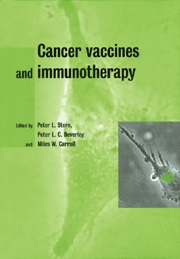Book contents
- Frontmatter
- Contents
- List of contributors
- 1 Immunity and cancer
- 2 Immunotherapy of bladder cancer
- 3 Poxviruses as vectors for cancer immunotherapy
- 4 Vaccinia-based human papillomavirus vaccines in cervical cancer
- 5 Vaccine delivery and immunosuppression in cervical cancer
- 6 Vaccines for colon cancer
- 7 MUC1 vaccines and breast cancer
- 8 Anti-idiotypic vaccination
- 9 Immunotherapy and vaccination against Epstein–Barr virus-associated cancer
- 10 Serologically identified tumour antigens as cancer vaccines
- 11 CTL-defined cancer vaccines in melanoma and other epithelial cancers
- 12 DNA vaccines against B-cell tumours
- 13 Dendritic cell approaches to immunotherapy
- 14 Overview
- 15 Recent developments
- Index
5 - Vaccine delivery and immunosuppression in cervical cancer
Published online by Cambridge University Press: 06 January 2010
- Frontmatter
- Contents
- List of contributors
- 1 Immunity and cancer
- 2 Immunotherapy of bladder cancer
- 3 Poxviruses as vectors for cancer immunotherapy
- 4 Vaccinia-based human papillomavirus vaccines in cervical cancer
- 5 Vaccine delivery and immunosuppression in cervical cancer
- 6 Vaccines for colon cancer
- 7 MUC1 vaccines and breast cancer
- 8 Anti-idiotypic vaccination
- 9 Immunotherapy and vaccination against Epstein–Barr virus-associated cancer
- 10 Serologically identified tumour antigens as cancer vaccines
- 11 CTL-defined cancer vaccines in melanoma and other epithelial cancers
- 12 DNA vaccines against B-cell tumours
- 13 Dendritic cell approaches to immunotherapy
- 14 Overview
- 15 Recent developments
- Index
Summary
Introduction
A correlation between human papillomavirus (HPV) infection of cervical epithelial cells and cervical cancer has been unequivocally established. A significant proportion of early-stage precancerous lesions, cervical intraepithelial neoplasia (CIN) and essentially all cervical carcinomas are positive for certain high-risk types of HPV. The potential for immunotherapeutic intervention directed against viral targets expressed in cervical neoplasia is discussed in this chapter.
Human papillomaviruses and cervical neoplasia
Epidemiology
Human papillomaviruses (HPVs) are the most common sexually transmitted viruses and there are over 90 different HPV types described so far, of which about 35 types infect the anogenital tract. The risk of infection is approximately the same for men as for women, but in general the infection rate for HPV is greater at a younger age (below 25 years) than later in life. Most HPV infections are subclinical and go unnoticed, although some infections may progress into benign lesions, like the common genital warts in the anogenital region. HPV genomic DNA is detected in approximately 10–15% of the sexually active adults in the United States, whereas approximately only 1% of the population show clinical manifestations of infection, cervical intraepithelial neoplasia CIN. Only a minority of these CIN lesions will later progress into cervical carcinomas and adenocarcinomas.
Analysis of biopsy material of CIN lesions and cervical carcinomas showed the prevalence of HPV 6 or HPV 11 in low-grade CIN lesions, whereas HPV 16 and HPV 18 dominated in high-grade CIN and cervical carcinoma samples.
- Type
- Chapter
- Information
- Cancer Vaccines and Immunotherapy , pp. 82 - 106Publisher: Cambridge University PressPrint publication year: 2000
- 2
- Cited by



